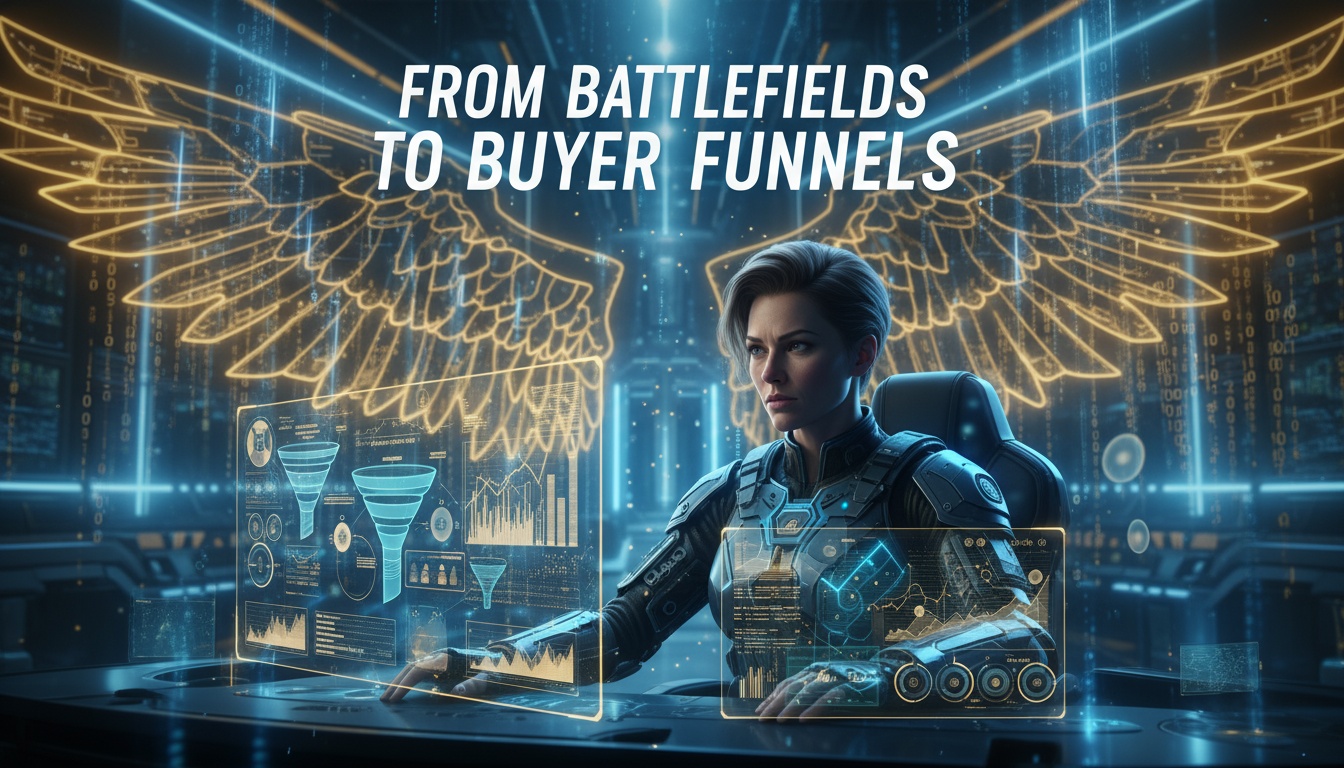Let me set the scene: Once upon a time, my website was about as busy as a mess hall after midnight. There was no traffic, no chatter, and no hope. If you’ve ever felt like you built ‘it’ and nobody came, this post is for you. I learned the hard way that getting attention isn’t about working harder, pounding on the digital door, or begging for mercy from the algorithm gods. Instead, it’s about strategic positioning, storytelling, and turning strangers into super-fans—by becoming the signal in their noisy world. Here’s how I did it (and how you can too).
Stop Playing Whack-a-Mole with Traffic: Start Using a Dream 100 Strategy
Let’s be real: I spent years playing traffic whack-a-mole. One week, I’m chasing Facebook likes. Next, I’m tossing money at Google ads, hoping something sticks. It was exhausting—and honestly, a little embarrassing. Then I stumbled on Russell Brunson’s Dream 100 Strategy, and everything changed.
Russell Brunson says, “Your audience already exists. Your mission? Move their attention to you.”
Finding My Ideal Clients’ Digital Hangouts
Instead of relying on the internet for opportunities, I began actively searching for them. I asked myself: Where do my ideal clients already hang out? Turns out, they weren’t hiding—they were just busy in Facebook groups for veterans, binge-watching YouTube channels about side hustles, and tuning into niche podcasts on financial freedom. Rather than searching widely, I developed a targeted list known as the Dream 100. These were the communities, influencers, and platforms where my dream clients gathered.
Relationship Building: Value First, Pitch Later
Here’s the kicker: I didn’t barge in waving my offer around like a flag. I became a value contributor. I shared real tips, told candid stories about my own transition, and offered solutions—no strings attached. It’s classic targeted marketing, but with a human touch. People remember the guy who helps, not the one who spams.
Shared actionable advice in group threads (not just motivational fluff).
Told stories about my wins and failures—because authenticity stands out.
Answered questions before anyone even thought to ask for my link.
Tracking What Actually Works
Not every group or platform is gold. I tracked which communities sparked real engagement and which were digital ghost towns. If there was no activity in a Facebook group, I decided to move on. However, when a YouTube comment resulted in a direct message or a podcast shoutout attracted subscribers, I intensified my efforts. That’s the beauty of the Dream 100 Strategy: it’s about efficient acquisition—focusing on high-value prospects, not just anyone with a pulse.
Personalization and persistence are key. When you show up consistently, deliver value, and build real relationships, you stop chasing cold traffic and start attracting warm, loyal buyers. That's how you transform a stagnant market into a thriving community—one Dream 100 connection at a time.
Funnels Should Filter, Not Just Catch: The Art of Pre-Qualifying Traffic
Let me tell you about the time I thought I’d cracked the code on lead generation. I sent out 100 free eBook offers to anyone who showed interest. Guess how many are stuck? Three. That’s right—3%. The rest? The remainder consisted of tire kickers, freebie hunters, and a few individuals who believed that "affiliate marketing" was a new cryptocurrency Ponzi scheme. That’s when it hit me: a marketing funnel isn’t a net. It’s a filter.
“A good funnel repels the wrong crowd.”
Most rookies build their funnels to catch as many leads as possible. They slap on a generic freebie and pray for conversions. But if you want to turn your business from ghost town to gold mine, you need a filter—a system that pre-qualifies traffic and attracts only the committed operators.
Quit Begging for Clicks—Attract Action-Takers
I stopped begging for clicks with bland lead magnets. Instead, I crafted offers that spoke directly to the pain and ambition of my dream customers. My opt-in pages started calling out the real struggles veterans face when transitioning to online business. Suddenly, the wrong crowd bounced, and the right people leaned in. That’s conversion optimization in action.
Test, Refine, and Speak Their Language
I tested my messaging relentlessly. Every headline, every email, and every follow-up sequence was designed to filter out the “just curious” and spotlight the “all-in” crowd. If someone dropped off after the first email, good. Less time spent wrangling with folks who’d never buy anyway.
Follow-Up: The Ultimate Filter
Here’s the secret sauce: my follow-up sequences did more than nurture—they weeded out the fence-sitters. I asked pointed questions, shared stories of real transformation, and made it clear this wasn’t for dabblers. The result? My lead generation increased significantly. I spent less time on the wrong prospects and more time helping those ready to win.
Systems like OfferLab teach this filter-first approach. They show you how to pre-qualify traffic so you’re not just filling your list—you’re building a squad of committed buyers. When your funnel does the heavy lifting, your conversions go up, your headaches go down, and your business finally feels like a gold mine instead of a ghost town.
Never Trust an Algorithm: Diversify Your Traffic Platoons
Let me tell you a hard-earned lesson from the trenches of online business: Never trust an algorithm with your livelihood. If you’re betting your entire traffic generation strategy on a single platform, you’re basically building your house on quicksand. I learned these lessons the hard way. One day, Facebook or YouTube can change a setting, and half your business disappears. “One day Facebook or YouTube can change a setting, and half your business disappears.” That’s the infamous ‘Zanos Snap’—and if you haven’t felt it yet, just wait.
Multi-Channel Outreach: Your Three-Pronged Defense
After one too many algorithm mood swings, I started splitting my efforts between three traffic platoons:
Organic Recon: I doubled down on content marketing—blog posts, SEO-optimized guides, and YouTube How-To videos. These evergreen assets keep working for you, bringing in search-driven discovery long after you hit publish.
Paid Artillery: Once my funnel was battle-tested, I fired up targeted ads. Paid traffic is like calling in air support: fast and powerful, but you need a solid system (and budget) to make it count.
Affiliate Allies: I formed alliances with creators who already had my dream audience. They vouch for my brand and send warm leads my way, and we both win. It’s partnership referrals at their finest.
Diversification: Your Insurance Policy
Here’s the truth: Multi-channel outreach isn’t just smart; it’s survival. When one channel goes silent, the others hold the line. I’ve seen entire businesses wiped out overnight because they put all their eggs in the Facebook basket. Not me. My traffic platoons keep leads flowing, rain or shine.
OfferLab Certification: Training for Sustainable Lead Gen
OfferLab’s Certification hammered this home. They teach you to orchestrate organic, paid, and affiliate channels so your acquisition engine never stalls. Research shows it takes 8–12 touchpoints before someone trusts you enough to buy—so why limit yourself to just one channel?
If you want to future-proof your customer acquisition, diversify your traffic sources. Algorithms are fickle, but a multi-channel, content marketing-driven approach is as close to bulletproof as it gets.
Why You Should Sell Belief, Not Just Products: Storytelling in Sales
Let’s get real—nobody wakes up thinking, “Man, I hope someone pitches me a funnel today.” What they want is change. As a veteran entrepreneur, I learned the difficult way: you don’t win hearts (or wallets) by rattling off product specs. You win by selling belief—by telling stories that make people feel the transformation you’ve lived.
During the period when my business was a digital ghost town, I was fixated on features—automation, integrations, and all the other attractive functionalities. Crickets. Then I flipped the script. I started sharing what life looked like before I discovered automation: late nights, missed family dinners, and the constant grind. I painted the Customer Value Journey—not with charts, but with real moments. When was the first time I successfully automated a campaign and managed to attend my child's soccer game? That story got more engagement than any sales pitch ever did.
The key is to remember that storytelling in sales is not about you. It’s about letting prospects see themselves in your journey. I discussed the doubts, the false starts, and the breakthrough—the moment I realized, “They don’t buy funnels—they buy freedom from confusion.” That line hit home because it’s true. Veterans aren’t looking for another tool; they’re looking for a path to autonomy, more time with family, and a mission that matters.
Share real transformation: Don’t just say “automation saves time”—show what that time means. For me, it was finally being present at home, not glued to my laptop.
Tap into veteran values: Autonomy, service, and brotherhood. I told stories about how entrepreneurship gave me a new unit—fellow vets building something together.
Let them see themselves: No high-pressure scripts. Just, “Here’s where I was, here’s what changed, and here’s how you can do it too.”
Relationship building is like dating your prospects. You don’t propose on the first DM. You build trust, deliver value, and let them feel the emotional payoff. That’s what moves browsers to buyers. Belief trumps product specs every time.
They don’t buy funnels—they buy freedom from confusion.
Keep Your Funnel Soldier-Ready: Regular Maintenance for Compounding Returns
Let me tell you a hard-earned truth from the trenches: conversion optimization isn’t a one-time victory lap. It’s a weekly ritual—a discipline, not a checkbox. Back when my business was more ghost town than gold mine, I learned fast that a sales funnel is only as strong as its weakest link. And trust me, nothing kills momentum faster than a broken opt-in page or a dead email sequence. Every click you earn is an asset—don’t let it slip through a leaky system.
Every Sunday night, I’d run my own “funnel inspection.” I tested every opt-in form, checked that emails actually landed in the inbox (not the spam abyss), and hunted down broken links before they could sabotage my reputation. I watched for engagement drop-offs like a hawk—if open rates dipped, I tweaked subject lines. If my lead magnet felt stale, I refreshed it. I never let my funnel get rusty, because I knew that continuous refinement was the only way to keep my business soldier-ready.
Here’s the kicker: a reliable sales funnel doesn’t just convert—it compounds. One click this week, one sale next month, all fueled by consistent follow-up and relentless fine-tuning. That’s the secret sauce most rookies miss. They build a funnel, launch it, and then move on, hoping for magic. But the real magic is in the maintenance. Each tweak, each test, each follow-up email is another round in the chamber—ready to fire when the time is right.
'A solid funnel doesn’t just convert—it compounds.'
So, if you want compounding returns, treat your funnel like your weapon: clean it, test it, and never assume it’s “good enough.” Celebrate the little wins—a single new subscriber, a reply to your nurture email, a sale that comes in from a follow-up you sent weeks ago. That’s how you turn every ounce of effort into long-term results. Conversion optimization is a process, not a one-off win. Stay vigilant, keep refining, and your funnel will multiply your efforts over months, not days. That’s how you breathe life into your business—one disciplined week at a time.



